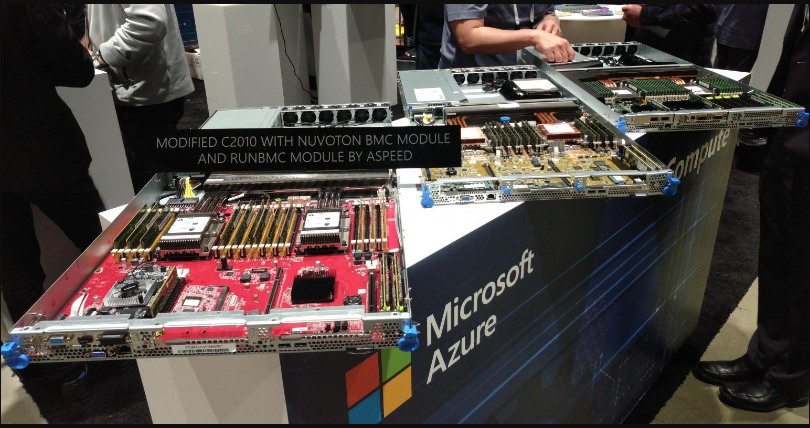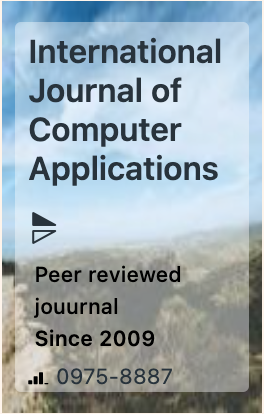The week's pick
Random Articles
Reseach Article
A Study of Cloud Security Frameworks for Safeguarding Multi-Tenant Cloud Architectures
| International Journal of Computer Applications |
| Foundation of Computer Science (FCS), NY, USA |
| Volume 186 - Number 60 |
| Year of Publication: 2025 |
| Authors: Srinivas Chippagiri |
 10.5120/ijca2025924369
10.5120/ijca2025924369
|
Srinivas Chippagiri . A Study of Cloud Security Frameworks for Safeguarding Multi-Tenant Cloud Architectures. International Journal of Computer Applications. 186, 60 ( Jan 2025), 50-57. DOI=10.5120/ijca2025924369
Abstract
Multi-tenancy in cloud computing allows multiple tenants to share resources efficiently, offering cost-effectiveness and scalability. However, this architectural design introduces complex security challenges, necessitating robust frameworks and strategies to safeguard sensitive data and maintain isolation among tenants. This paper explores multi-tenancy security concerns and solutions, emphasizing data isolation, unauthorized access prevention, and compliance with regulations. Key techniques, such as virtual and organic multi-tenancy and data storage strategies, ranging from separate applications to shared databases, are analyzed. Furthermore, security frameworks such as the Shared Responsibility Model, Identity and Access Management (IAM), data protection mechanisms, and network security are discussed. Advanced technologies, including confidential computing and homomorphic encryption, are highlighted for their potential to enhance security in multi-tenant environments. The paper underscores the importance of addressing tenant isolation, data encryption, compliance requirements, and availability risks to ensure a secure and resilient multi-tenant cloud infrastructure.
References
- M. S. S. and R. S., “Security Architecture for multi-Tenant Cloud Migration,” Int. J. Futur. Comput. Commun., 2018, doi: 10.18178/ijfcc.2018.7.2.518.
- M. N. Kumar, P. Sujatha, V. Kalva, R. Nagori, A. K. Katukojwala, and M. Kumar, “Mitigating economic denial of sustainability (EDoS) in cloud computing using in-cloud scrubber service,” in Proceedings - 4th International Conference on Computational Intelligence and Communication Networks, CICN 2012, 2012. doi: 10.1109/CICN.2012.149.
- A. Tripathi and A. Mishra, “Cloud computing security considerations,” in 2011 IEEE International Conference on Signal Processing, Communications and Computing, ICSPCC 2011, 2011. doi: 10.1109/ICSPCC.2011.6061557.
- J. J. Wang and S. Mu, “Security issues and countermeasures in cloud computing,” in Proceedings of 2011 IEEE International Conference on Grey Systems and Intelligent Services, GSIS’11 - Joint with the 15th WOSC International Congress on Cybernetics and Systems, 2011. doi: 10.1109/GSIS.2011.6043978.
- Ramesh Bishukarma, “Privacy-preserving based encryption techniques for securing data in cloud computing environments,” Int. J. Sci. Res. Arch., vol. 9, no. 2, pp. 1014–1025, Aug. 2023, doi: 10.30574/ijsra.2023.9.2.0441.
- S. Arora and P. Khare, “AI/ML-Enabled Optimization of Edge Infrastructure: Enhancing Performance and Security,” Int. J. Adv. Res. Sci. Commun. Technol., vol. 4, pp. 230–242, 2024.
- M. Darwish, A. Ouda, and L. F. Capretz, “Cloud-based DDoS attacks and defenses,” in International Conference on Information Society, i-Society 2013, 2013.
- R. Bishukarma, “Adaptive AI-Based Anomaly Detection Framework for SaaS Platform Security,” Int. J. Curr. Eng. Technol., vol. 12, no. 07, pp. 541–548, 2022, doi: https://doi.org/10.14741/ijcet/v.12.6.8.
- P. Khare and S. Arora, “Predicting Customer Churn in SaaS Products using Machine Learning,” Int. Res. J. Eng. Technol., vol. 11, no. 5, 2024, [Online]. Available: https://www.researchgate.net/publication/380720098_Prdicting_Customer_Churn_in_SaaS_Products_using_Machine_Learning
- R. Bishukarma, “Optimising Cloud Security in Multi-Cloud Environments : A Study of Best Practices,” TIJER – Int. Res. J., vol. 11, no. 11, pp. 590–598, 2024.
- M. H. Hashmi, M. Affan, and R. Tandon, “A Customize Battery Management Approach for Satellite,” in 2023 24th International Carpathian Control Conference (ICCC), IEEE, Jun. 2023, pp. 173–178. doi: 10.1109/ICCC57093.2023.10178893.
- R. Bishukarma, “Scalable Zero-Trust Architectures for Enhancing Security in Multi-Cloud SaaS Platforms,” Int. J. Adv. Res. Sci. Commun. Technol., vol. 3, no. 3, pp. 1308–1319, 2023, doi: 10.48175/IJARSCT-14000S.
- M. M. Rajeev Arora, Aniruddh Tiwari, “Advanced Blockchain-Enabled Deep Quantum Computing Model for Secured Machine to Machine Communication,” ICASET2024 Int. Conf. Adv. Sci. Eng. Technol., 2024.
- A. P. A. Singh, “Streamlining Purchase Requisitions and Orders : A Guide to Effective Goods Receipt Management,” J. Emerg. Technol. Innov. Res., vol. 8, no. 5, pp. g179–g184, 2021.
- R. Bishukarma, “The Role of AI in Automated Testing and Monitoring in SaaS Environments,” IJRAR, vol. 8, no. 2, 2021, [Online]. Available: https://www.ijrar.org/papers/IJRAR21B2597.pdf
- R. Arora, A. Soni, R. Garine, and A. Kumar, “Impact of Cloud-Based Mobile Application during Pandemic (Covid-19).” 2024. doi: 10.2139/ssrn.4935564.
- G. B. Pallavi and P. Jayarekha, “Secure and efficient multi-tenant database management system for cloud computing environment,” Int. J. Inf. Technol., 2022, doi: 10.1007/s41870-019-00416-5.
- K. Patel, “A review on cloud computing-based quality assurance : Challenges , opportunities , and best practices,” Int. J. Sci. Res. Arch., vol. 13, no. 01, pp. 796–805, 2024.
- K. Patel, “Exploring the Combined Effort Between Software Testing and Quality Assurance: A Review of Current Practices and Future,” Int. Res. J. Eng. Technol., vol. 11, no. 09, pp. 522–529, 2024.
- H. Aljahdali, A. Albatli, P. Garraghan, P. Townend, L. Lau, and J. Xu, “Multi-tenancy in cloud computing,” in Proceedings - IEEE 8th International Symposium on Service Oriented System Engineering, SOSE 2014, 2014. doi: 10.1109/SOSE.2014.50.
- A. P. A. Singh and N. Gameti, “Leveraging Digital Twins for Predictive Maintenance: Techniques, Challenges, and Application,” IJSART, vol. 10, no. 09, pp. 118–128, 2024.
- D. Prava and S. B. L. Raina, “A Security Challenges in Multi-Tenant Cloud Computing,” vol. XV, no. 1, pp. 941–946, 2018.
- G. Karataş, F. Can, G. Doǧan, C. Konca, and A. Akbulut, “Multi-tenant architectures in the cloud: A systematic mapping study,” in IDAP 2017 - International Artificial Intelligence and Data Processing Symposium, 2017. doi: 10.1109/IDAP.2017.8090268.
- J. Thomas, K. V. Vedi, and S. Gupta, “Effects of supply chain management strategies on the overall performance of the organization,” Int. J. Sci. Res. Arch., vol. 13, no. 01, pp. 709–719, 2024.
- J. Thomas, H. Volikatla, J. Vummadi, and R. Shah, “AI-Enhanced Demand Forecasting Dashboard Device Having Interface for Optimal Inventory Management.” 2024.
- M. S. Rajeev Arora, Sheetal Gera, “Impact of Cloud Computing Services and Application in Healthcare Sector and to provide improved quality patient care,” IEEE Int. Conf. Cloud Comput. Emerg. Mark. (CCEM), NJ, USA, 2021, pp. 45–47, 2021.
- H. S. Chandu, “A Survey of Memory Controller Architectures: Design Trends and Performance Trade-offs,” Int. J. Res. Anal. Rev., vol. 9, no. 4, pp. 930–936, 2022.
- Sahil Arora and Apoorva Tewari, “Fortifying Critical Infrastructures: Secure Data Management with Edge Computing,” Int. J. Adv. Res. Sci. Commun. Technol., vol. 3, no. 2, pp. 946–955, Aug. 2023, doi: 10.48175/IJARSCT-12743E.
- Sahil Arora and Apoorva Tewari, “Zero trust architecture in IAM with AI integration,” Int. J. Sci. Res. Arch., vol. 8, no. 2, pp. 737–745, Apr. 2023, doi: 10.30574/ijsra.2023.8.2.0163.
- M. Z. Hasan, R. Fink, M. R. Suyambu, and M. K. Baskaran, “Assessment and improvement of intelligent controllers for elevator energy efficiency,” in IEEE International Conference on Electro Information Technology, 2012. doi: 10.1109/EIT.2012.6220727.
- V. K. Y. Nicholas Richardson, Rajani Pydipalli, Sai Sirisha Maddula, Sunil Kumar Reddy Anumandla, “Role-Based Access Control in SAS Programming: Enhancing Security and Authorization,” Int. J. Reciprocal Symmetry Theor. Phys., vol. 6, no. 1, pp. 31–42, 2019.
- S. Arora, P. Khare, and S. Gupta, “A Machine Learning for Role Based Access Control: Optimizing Role Management and Permission Management,” in 2024 First International Conference on Pioneering Developments in Computer Science & Digital Technologies (IC2SDT), 2024, pp. 158–163. doi: 10.1109/IC2SDT62152.2024.10696236.
Index Terms
Keywords

